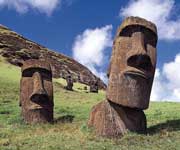Rapa Nui, the indigenous name of Easter Island, bears witness to a unique cultural phenomenon. A society of Polynesian origin that settled there c. A.D. 300 established a powerful, imaginative and original tradition of monumental sculpture and architecture, free from any external influence. From the 10th to the 16th century this society built shrines and erected enormous stone figures known as moai , which created an unrivalled cultural landscape that continues to fascinate people throughout the world. Rapa Nui contains one of the most remarkable cultural phenomena in the world.

Continent: South America
Country: Chile
Category: Cultural
Criterion: (I) (III) (V)
Date of Inscription: 1995
Unparalleled cultural landscape
An artistic and architectural tradition of great power and imagination was developed by a society completely isolated from external cultural influences of any kind for over a millennium. The substantial remains of this culture blend with their natural surroundings to create an unparalleled cultural landscape.
 |
| Moai Stone Figures |









I love travel to historical places.
ReplyDelete